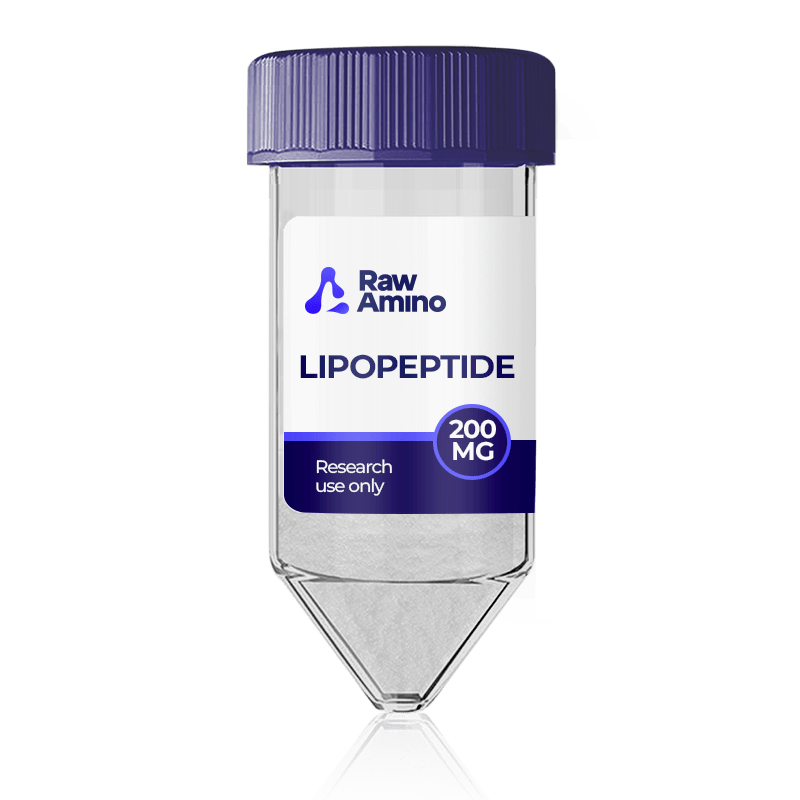
Lipopeptide – 200MG
$202.00
Discount per Quantity
| Quantity | Discount | Price |
|---|---|---|
| 5 - 8 | 5% | $191.90 |
| 9 + | 10% | $181.80 |
Scientific Overview of Lipopeptide
Lipopeptide, also referred to as Biopeptide EL or palmitoyl hexapeptide-12, is a synthetic peptide designed with both amino acid and lipid components. The structure includes six amino acids arranged in a sequence (valine-glycine-valine-alanine-proline-glycine) that is naturally found within elastin and its precursor protein, tropoelastin. By incorporating a palmitic acid chain, the peptide may demonstrate improved stability and penetration through cellular layers during laboratory studies.
This dual design — combining a lipid with a peptide fragment — has been of particular interest to researchers investigating extracellular matrix (ECM) activity. Because its sequence mirrors elastin motifs, lipopeptide is studied for its potential to interact with fibroblast cells, which are central to connective tissue function and maintenance. In-vitro research suggests that such interactions may influence the production of ECM proteins, including collagen, elastin, and glycosaminoglycans such as hyaluronic acid. These investigations highlight lipopeptide as a candidate for probing cell-matrix communication and protein regulation within controlled experimental settings.
Alternative Names: Biopeptide EL, Palmitoyl Hexapeptide-12, Oligopeptide-34
Lipopeptide Studies and Research Data
Laboratory Exploration of Fibroblast Activity
Several experimental studies have focused on how lipopeptide may interact with fibroblast function. Fibroblasts are responsible for synthesizing much of the ECM, including collagen and elastin fibers. Findings suggest that lipopeptide might encourage fibroblasts to adjust their output of key proteins such as collagen and hyaluronic acid. At the same time, some laboratory data imply that elastin synthesis may be downregulated through feedback mechanisms, possibly due to the peptide’s similarity to elastin-derived sequences. This dual potential — stimulation of some proteins while moderating others — highlights the complexity of fibroblast regulation under experimental exposure to lipopeptide.
Observations on Fibroblast Growth Patterns
Research also indicates that fibroblast proliferation may be influenced by exposure to lipopeptide. Reports propose that the peptide’s repeating elastin-like motif (VGVAPG) could engage with specific, though not fully identified, receptors on fibroblast surfaces. Such interactions may initiate intracellular signaling pathways that stimulate cell division and alter fibroblast morphology. Studies have described a potential lag phase before proliferation begins, which may depend on initial cell density. Observations also include changes in cell shape, suggesting that lipopeptide exposure could not only affect fibroblast growth but also influence their organization and function within tissue models.
Lipopeptide Potential Role in Fibroblast Migration
Another recurring theme in laboratory investigations involves fibroblast migration. Experimental work proposes that the VGVAPG sequence may act as a chemotactic signal, guiding fibroblasts toward regions where extracellular matrix remodeling is required. However, responsiveness to this signaling appears dependent on the differentiation state of the fibroblasts. More mature cells, capable of elastin production, seem to respond more strongly to lipopeptide exposure, whereas undifferentiated fibroblasts show limited migration. This suggests that lipopeptide might preferentially influence functionally active fibroblast populations in experimental conditions.
Lipopeptide Investigations into Pigmentation Pathways
Beyond fibroblast regulation, lipopeptide has also been studied for its potential influence on pigmentation-related processes. In-vitro models suggest that the peptide may alter melanocyte activity by downregulating gene expression associated with melanin synthesis. Laboratory data point to possible suppression of transcription factors such as MITF, as well as enzymes like tyrosinase and dopachrome tautomerase, which are integral to melanogenesis. These findings imply that lipopeptide may be a useful tool for studying pathways involved in pigmentation modulation and gene regulation in melanocyte models.
Lipopeptide Connections to Inflammatory Signaling
Lipopeptide has also been explored in the context of cellular signaling related to inflammation. Studies propose that the peptide may adjust the expression of cytokines such as interleukin-6 (IL-6), interleukin-1 (IL-1), and interleukin-8 (IL-8). Since these signaling molecules are associated with cellular stress responses and extracellular matrix turnover, lipopeptide’s modulation of their levels could provide insights into how peptides influence cytokine cascades. Some research further suggests that lipopeptide may indirectly impact enzymes known as matrix metalloproteinases (MMPs), which are capable of breaking down ECM proteins. This connection underscores its potential role in experimental models investigating tissue remodeling.
Conclusion
Taken together, the body of research on lipopeptide suggests it is a multifaceted peptide-lipid hybrid that may influence fibroblast activity, cell migration, pigmentation pathways, and cytokine regulation. Although much of this work remains exploratory, the peptide provides a valuable model for understanding how small synthetic peptides designed with natural protein motifs can interact with complex cellular systems.
References
- Veiga, E., Ferreira, L., Correia, M., Pires, P. C., Hameed, H., Araújo, A. R., ... & Paiva-Santos, A. C. (2023). Anti-aging peptides for advanced skincare: focus on nanodelivery systems. Journal of Drug Delivery Science and Technology, 105087.
- Tajima, S., Wachi, H., Uemura, Y., & Okamoto, K. (1997). Modulation by elastin peptide VGVAPG of cell proliferation and elastin expression in human skin fibroblasts. Archives of dermatological research, 289(8), 489–492.
- Schagen, S. K. (2017). Topical peptide treatments with effective anti-aging results. Cosmetics, 4(2), 16.
- Senior, R. M., Griffin, G. L., Mecham, R. P., Wrenn, D. S., Prasad, K. U., & Urry, D. W. (1984). Val-Gly-Val-Ala-Pro-Gly, a repeating peptide in elastin, is chemotactic for fibroblasts and monocytes. Journal of Cell Biology, 99(3), 870–874.
- Al-Atif, H. (2022). Collagen supplements for aging and wrinkles: A paradigm shift in the fields of dermatology and cosmetics. Dermatol Pract Concept, 12(1), e2022018.
- Kamoun, A., Landeau, J. M., Godeau, G., Wallach, J., Duchesnay, A., Pellat, B., & Hornebeck, W. (1995). Growth stimulation of human skin fibroblasts by elastin-derived peptides. Cell adhesion and communication, 3(4), 273–281.
- Ngoc, L. T. N., Moon, J. Y., & Lee, Y. C. (2023). Insights into bioactive peptides in cosmetics. Cosmetics, 10(4), 111.
- Floquet, N., Héry-Huynh, S., Dauchez, M., Derreumaux, P., Tamburro, A. M., & Alix, A. J. (2004). Structural characterization of VGVAPG, an elastin-derived peptide. Biopolymers, 76(3), 266–280.
- Widgerow, A., Wang, J., Ziegler, M., Fabi, S., Garruto, J., Robinson, D., & Bell, M. (2022). Advances in pigmentation management: A multipronged approach. Journal of Drugs in Dermatology, 21(11), 1206–1220.
Disclaimer:
The products mentioned are intended solely for laboratory research and in-vitro experimentation. They are not approved for human or animal use of any kind. All details provided are for educational purposes only. By purchasing from this site, you agree to comply with our Terms and Conditions.
19 reviews for Lipopeptide – 200MG
Only logged in customers may leave a review.
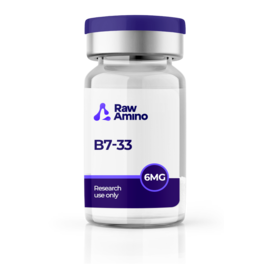
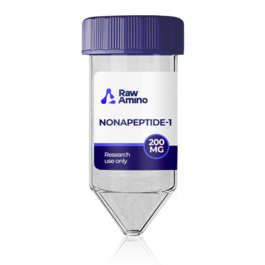
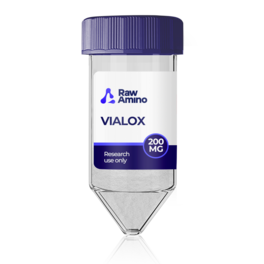
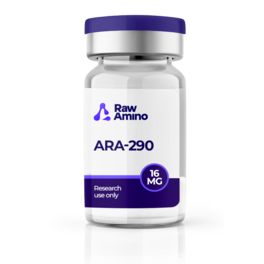
thompson joshua –
quinn r –
Samuel N –
catherine Fernadez –
jennifer kaily –
nelson sharon –
You guys are my go-to peptide supplier of all times. I love everything about you, from peptides, to CS, deals and offers, everything fits.
Skyline Cities –
This supply here is kinda rarely used, as I’ve noticed, but I appreciate how they have articles on their product pages about all products they have in stock. There are the descriptions, which support, but sometimes you want to do a bit of research and I love how you don’t have to do Google searches n other places
matthew M –
jennifer kelley –
Take all of my money lol
Heather O –
vanessa M –
bryan J –
laura klein –
calderon christopher –
white victoria –
James R –
Joseph Z –
wanda V –
diana johns –